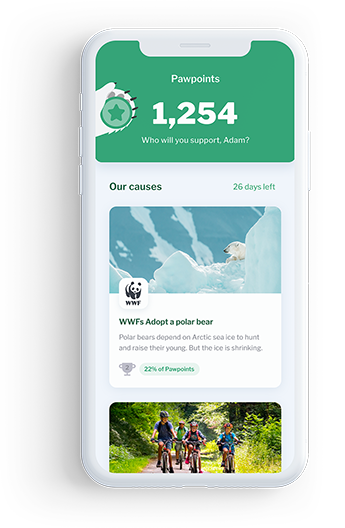SUSTAINABILITY
Measuring your individual impact
Introducing Pawprint, a new app that educates employees on their personal carbon footprint.
Measuring Your Individual Impact audio version | 6 mins | Listen now
M
eet Bjorn. He’s a friendly polar bear who is keen to help companies achieve their net zero ambitions.
Bjorn is the emblem of Pawprint, a self-professed eco companion, which has been created to align entire workforces around their employers’ climate targets.
Pawprint ‘came from the realisation that there was a gap between connecting every employee to a company’s Net Zero goals’, explains founder Christian Arno. ‘How can you educate your employees around the science underlying it?’
And, with more companies adopting a hybrid working style, Pawprint can play a role in helping companies calculate and ultimately reduce their Scope 3 emissions, not just in relation to business travel and employee commuting, but also in how employees expend energy at home throughout their working days.
Importantly, Scope 3 emissions typically make up the bulk of an organisation’s carbon footprint.
The key, according to Arno, is not to make people feel bad about their carbon footprint and the consumption habits they have developed through their lives, but instead to motivate them about changes they can make.
This is how it fits within what our business wants to do, and how we can align our climate targets with our business targets and accelerate change
‘Once you’ve got people who are educated, motivated and feel this could be fun, rather than somebody telling them that they’ve been a bad person, then you can say This is how it fits within what our business wants to do, and how we can align our climate targets with our business targets and accelerate change,’ he explains.
But Arno concedes that different generations might be more motivated than others. ‘My ambition is that Pawprint can connect the different stakeholders within a business, but for those people in their 20s and 30s, it can be a vehicle for them to support the business, accelerate transition to zero targets and for them to rekindle a belief in their organisations. People in their 40s and 50s also care just as much, but possibly don’t feel it in such a visceral way.’
Pawprint comprises, according to Arno, a ‘managed platform’ which involves both a technology platform and a customer success team. The technology comprises a business dashboard and an app, which allows individuals to measure, understand and reduce their personal carbon footprints. ‘We’ve got our non-judgmental bear Bjorn on hand to support you,’ he adds. ‘Bjorn is the friend who doesn’t judge you but is really knowledgeable on the topic. He could be Mike Berners-Lee.’
Mike Berners-Lee is the author of How Bad are Bananas? The carbon footprint of almost everything, who has worked with Pawprint since its early days to ensure that the scientific data provided is accurate. Within the app is an Eco Perks feature, which allows employers to financially support employees as they seek to reduce carbon emissions at home and at work.

We have seen the biggest carbon and cost reductions when people willingly downgrade from business class to economy
While all the information provided by employees is confidential, the business dashboard displays aggregated and anonymised data. ‘Businesses can start to learn more about employees, their actions and habits, the things they are willing to do and the things that they are not, and also how they feel about what the business is doing,’ says Arno. ‘They can benchmark everything, different divisions, different departments and even how they are doing versus other companies.’
Pawprint would rather that employees were not simply told to download its app. ‘We have these six pillars. The first time they might hear about us is from a communication, ideally from the chief executive or somebody senior, who tells them that they are building a relationship with Pawprint and would like to get employees more involved, that they want to engage them and that they see a business benefit in doing this.’
Prior to this introduction, the business should already have measured its carbon footprint and set goals, which could be aligned to science-based targets, or simply business objectives. ‘The classic one usually relates to business travel,’ says Arno.
‘The business will know how much it is spending on business travel and how many people are travelling business class. Where we have seen the biggest carbon and cost reductions is where people are willingly downgrading from business class to economy.’ Carbon calculators score business class emissions more highly than economy class because the seats take up more space.

Pawprint works better where the goals are clear, otherwise it can seem frivolous, which is not the case
‘Pawprint works better where the goals are clear, otherwise it can seem frivolous, which is not the case. We’ve seen a lot of variability in how successfully companies roll this out. Those that are hard-nosed and business-like in terms of setting goals and following the six pillars get great results.’
Employees are invited to participate over a period of a 28-day ‘sprint’, and are divided into teams. Leader boards record the teams’ progress. ‘If you and I are on the same team, I am much more likely to make the effort to walk into work rather than get an Uber, or whatever, because I don’t want to let you down. My progress is visible to you, and vice versa,’ explains Arno. ‘Every week, you give people reports, anecdotes and potentially incentives, which get the energy going. Since we added the leader board capability, engagement levels have gone up a lot.

As people take on these actions, they earn Paw Points which can be used to vote for climate friendly charities
‘Being top of the leader board gives people intrinsic motivation, whether that’s at an individual or team level. We’re trying to go light on extrinsic motivation, where people receive money or cash equivalents, but as people take on these actions, and hopefully form them into habits, they earn Paw Points, which can be used to vote for climate friendly charities.’
The app – there is also a free consumer version – contains about 600 actions, which are bunched together by themes, such as saving money, saving energy or health. ‘Within a sprint, employees are presented with a curated number of actions and encouraged to take on one a week. The employer will make a call on what is relevant to them: if the company is already full of vegans, it is less likely to be diet-related, for example,’ he explains. ‘Each action has a carbon number associated with it, which is related to its overall impact. We try to take these actions and turn them into habits. If you log them typically somewhere between five and eight times, that is considered a habit and gets locked into your Pawprint, which is another form of motivation.’
One of Pawprint’s actions encourages employees to bleed their home radiators. ‘It can save between £200 and £400 a year when it is used markedly,’ he explains. ‘We look at reducing the carbon footprint of their food, by making sure that people [do not waste as much]. We’ve got an action around using broccoli stalks and others around repurposing leftovers. There’s quite a lot of actions [for the home], and it can get quite addictive trying to find out what is the next most impactful action. Behavioural change is what is going to make the most difference in the affluent West.’